Equality and Diversity: Challenges and Strategies for Carter & Ward
VerifiedAdded on 2023/01/11
|29
|7776
|61
Report
AI Summary
This report examines the concepts of equality and diversity within the context of the Carter and Ward organization, an estate industry firm. The report delves into the core meanings of these concepts and explores the challenges that arise during their implementation, including issues related to employee management and diverse backgrounds. It further analyzes strategies for addressing these challenges, focusing on policy formulation and effective implementation. The research employs a project management plan, including cost analysis, scope definition, timelines, communication strategies, and risk mitigation. A literature review provides the foundation for understanding the complexities of equality and diversity, including the importance of legal compliance and the impact on employee motivation and organizational image. The report concludes with recommendations for promoting diversity and maintaining employee productivity.
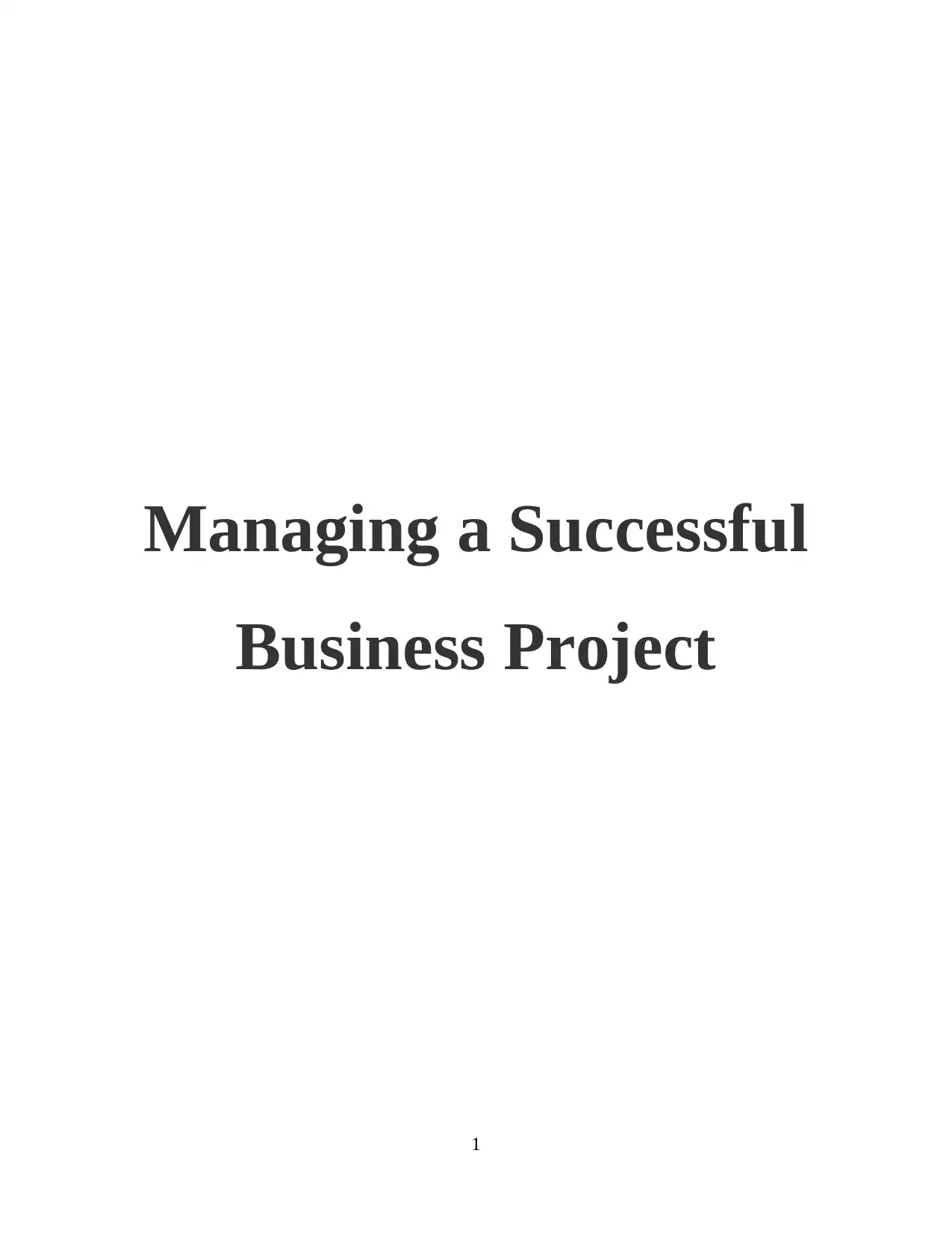
Managing a Successful
Business Project
1
Business Project
1
Paraphrase This Document
Need a fresh take? Get an instant paraphrase of this document with our AI Paraphraser
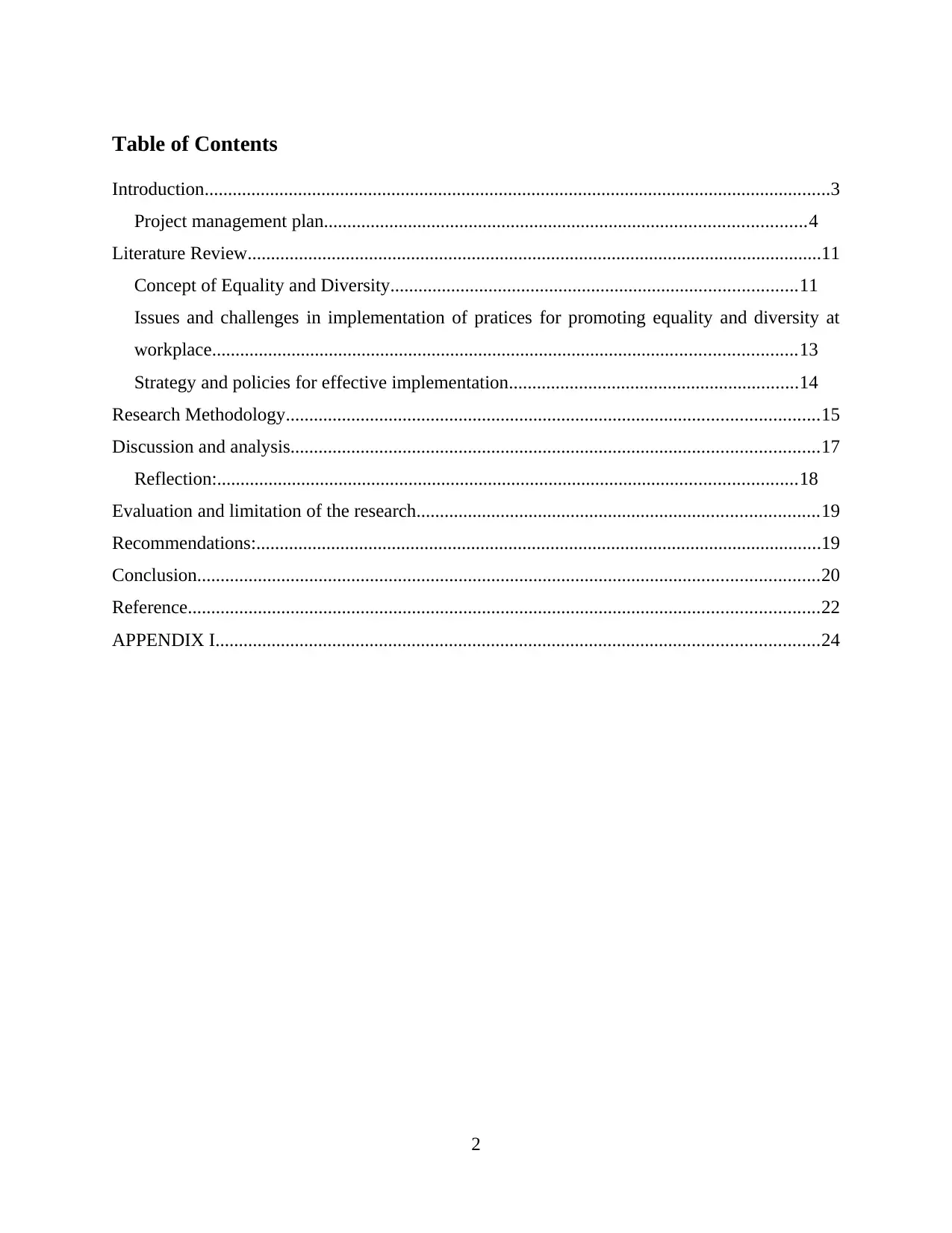
Table of Contents
Introduction......................................................................................................................................3
Project management plan.......................................................................................................4
Literature Review...........................................................................................................................11
Concept of Equality and Diversity.......................................................................................11
Issues and challenges in implementation of pratices for promoting equality and diversity at
workplace.............................................................................................................................13
Strategy and policies for effective implementation..............................................................14
Research Methodology..................................................................................................................15
Discussion and analysis.................................................................................................................17
Reflection:............................................................................................................................18
Evaluation and limitation of the research......................................................................................19
Recommendations:.........................................................................................................................19
Conclusion.....................................................................................................................................20
Reference.......................................................................................................................................22
APPENDIX I.................................................................................................................................24
2
Introduction......................................................................................................................................3
Project management plan.......................................................................................................4
Literature Review...........................................................................................................................11
Concept of Equality and Diversity.......................................................................................11
Issues and challenges in implementation of pratices for promoting equality and diversity at
workplace.............................................................................................................................13
Strategy and policies for effective implementation..............................................................14
Research Methodology..................................................................................................................15
Discussion and analysis.................................................................................................................17
Reflection:............................................................................................................................18
Evaluation and limitation of the research......................................................................................19
Recommendations:.........................................................................................................................19
Conclusion.....................................................................................................................................20
Reference.......................................................................................................................................22
APPENDIX I.................................................................................................................................24
2
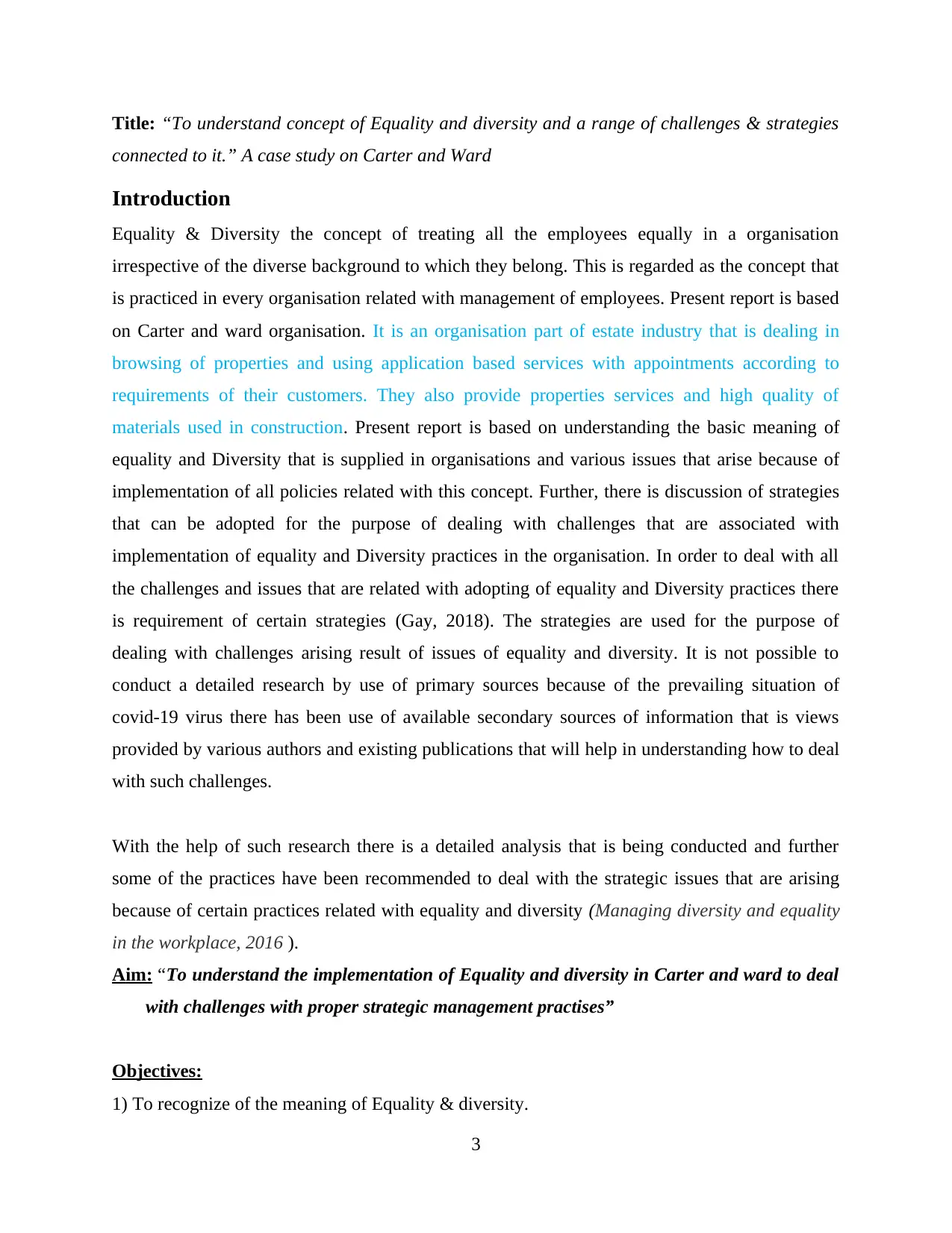
Title: “To understand concept of Equality and diversity and a range of challenges & strategies
connected to it.” A case study on Carter and Ward
Introduction
Equality & Diversity the concept of treating all the employees equally in a organisation
irrespective of the diverse background to which they belong. This is regarded as the concept that
is practiced in every organisation related with management of employees. Present report is based
on Carter and ward organisation. It is an organisation part of estate industry that is dealing in
browsing of properties and using application based services with appointments according to
requirements of their customers. They also provide properties services and high quality of
materials used in construction. Present report is based on understanding the basic meaning of
equality and Diversity that is supplied in organisations and various issues that arise because of
implementation of all policies related with this concept. Further, there is discussion of strategies
that can be adopted for the purpose of dealing with challenges that are associated with
implementation of equality and Diversity practices in the organisation. In order to deal with all
the challenges and issues that are related with adopting of equality and Diversity practices there
is requirement of certain strategies (Gay, 2018). The strategies are used for the purpose of
dealing with challenges arising result of issues of equality and diversity. It is not possible to
conduct a detailed research by use of primary sources because of the prevailing situation of
covid-19 virus there has been use of available secondary sources of information that is views
provided by various authors and existing publications that will help in understanding how to deal
with such challenges.
With the help of such research there is a detailed analysis that is being conducted and further
some of the practices have been recommended to deal with the strategic issues that are arising
because of certain practices related with equality and diversity (Managing diversity and equality
in the workplace, 2016 ).
Aim: “To understand the implementation of Equality and diversity in Carter and ward to deal
with challenges with proper strategic management practises”
Objectives:
1) To recognize of the meaning of Equality & diversity.
3
connected to it.” A case study on Carter and Ward
Introduction
Equality & Diversity the concept of treating all the employees equally in a organisation
irrespective of the diverse background to which they belong. This is regarded as the concept that
is practiced in every organisation related with management of employees. Present report is based
on Carter and ward organisation. It is an organisation part of estate industry that is dealing in
browsing of properties and using application based services with appointments according to
requirements of their customers. They also provide properties services and high quality of
materials used in construction. Present report is based on understanding the basic meaning of
equality and Diversity that is supplied in organisations and various issues that arise because of
implementation of all policies related with this concept. Further, there is discussion of strategies
that can be adopted for the purpose of dealing with challenges that are associated with
implementation of equality and Diversity practices in the organisation. In order to deal with all
the challenges and issues that are related with adopting of equality and Diversity practices there
is requirement of certain strategies (Gay, 2018). The strategies are used for the purpose of
dealing with challenges arising result of issues of equality and diversity. It is not possible to
conduct a detailed research by use of primary sources because of the prevailing situation of
covid-19 virus there has been use of available secondary sources of information that is views
provided by various authors and existing publications that will help in understanding how to deal
with such challenges.
With the help of such research there is a detailed analysis that is being conducted and further
some of the practices have been recommended to deal with the strategic issues that are arising
because of certain practices related with equality and diversity (Managing diversity and equality
in the workplace, 2016 ).
Aim: “To understand the implementation of Equality and diversity in Carter and ward to deal
with challenges with proper strategic management practises”
Objectives:
1) To recognize of the meaning of Equality & diversity.
3
⊘ This is a preview!⊘
Do you want full access?
Subscribe today to unlock all pages.

Trusted by 1+ million students worldwide
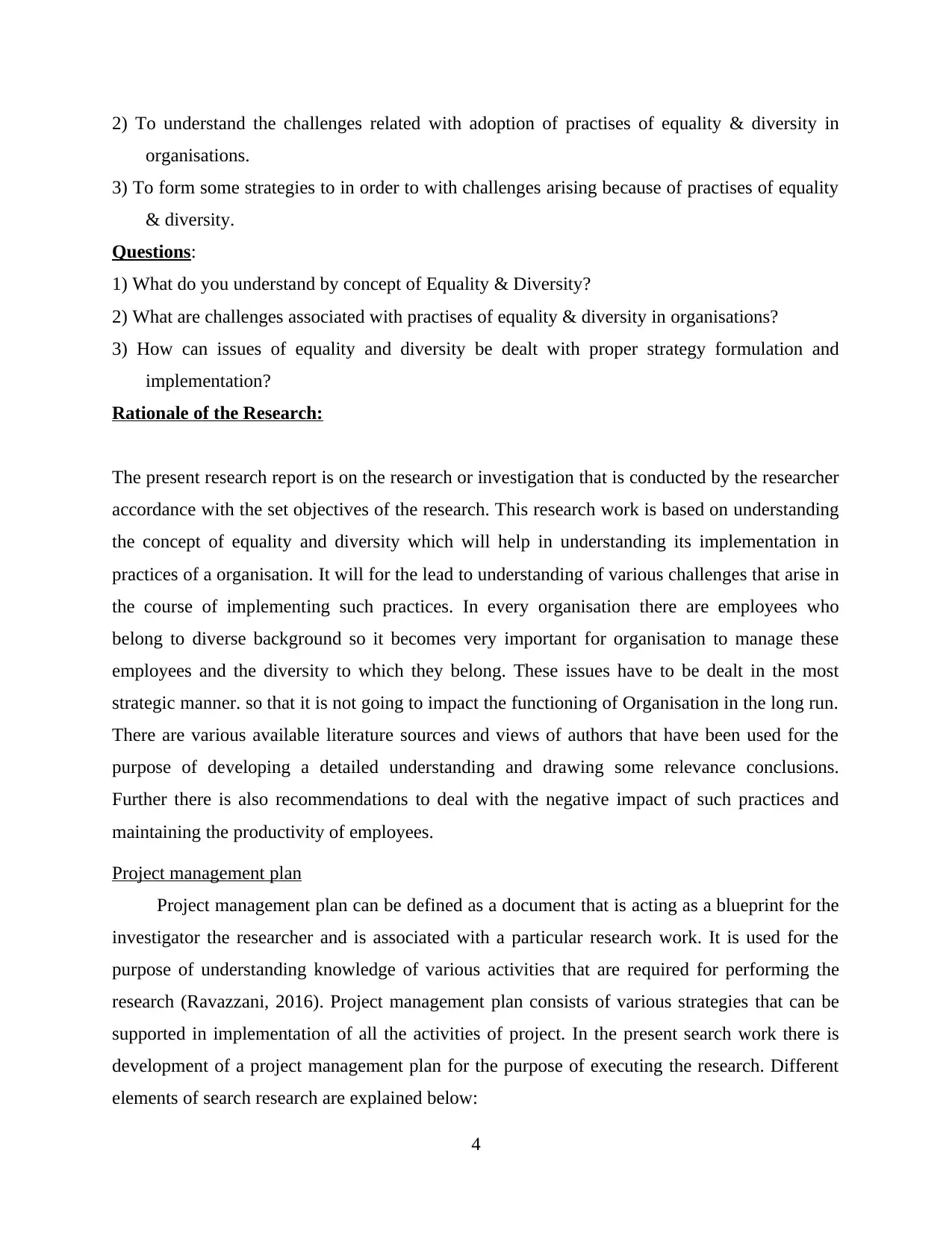
2) To understand the challenges related with adoption of practises of equality & diversity in
organisations.
3) To form some strategies to in order to with challenges arising because of practises of equality
& diversity.
Questions:
1) What do you understand by concept of Equality & Diversity?
2) What are challenges associated with practises of equality & diversity in organisations?
3) How can issues of equality and diversity be dealt with proper strategy formulation and
implementation?
Rationale of the Research:
The present research report is on the research or investigation that is conducted by the researcher
accordance with the set objectives of the research. This research work is based on understanding
the concept of equality and diversity which will help in understanding its implementation in
practices of a organisation. It will for the lead to understanding of various challenges that arise in
the course of implementing such practices. In every organisation there are employees who
belong to diverse background so it becomes very important for organisation to manage these
employees and the diversity to which they belong. These issues have to be dealt in the most
strategic manner. so that it is not going to impact the functioning of Organisation in the long run.
There are various available literature sources and views of authors that have been used for the
purpose of developing a detailed understanding and drawing some relevance conclusions.
Further there is also recommendations to deal with the negative impact of such practices and
maintaining the productivity of employees.
Project management plan
Project management plan can be defined as a document that is acting as a blueprint for the
investigator the researcher and is associated with a particular research work. It is used for the
purpose of understanding knowledge of various activities that are required for performing the
research (Ravazzani, 2016). Project management plan consists of various strategies that can be
supported in implementation of all the activities of project. In the present search work there is
development of a project management plan for the purpose of executing the research. Different
elements of search research are explained below:
4
organisations.
3) To form some strategies to in order to with challenges arising because of practises of equality
& diversity.
Questions:
1) What do you understand by concept of Equality & Diversity?
2) What are challenges associated with practises of equality & diversity in organisations?
3) How can issues of equality and diversity be dealt with proper strategy formulation and
implementation?
Rationale of the Research:
The present research report is on the research or investigation that is conducted by the researcher
accordance with the set objectives of the research. This research work is based on understanding
the concept of equality and diversity which will help in understanding its implementation in
practices of a organisation. It will for the lead to understanding of various challenges that arise in
the course of implementing such practices. In every organisation there are employees who
belong to diverse background so it becomes very important for organisation to manage these
employees and the diversity to which they belong. These issues have to be dealt in the most
strategic manner. so that it is not going to impact the functioning of Organisation in the long run.
There are various available literature sources and views of authors that have been used for the
purpose of developing a detailed understanding and drawing some relevance conclusions.
Further there is also recommendations to deal with the negative impact of such practices and
maintaining the productivity of employees.
Project management plan
Project management plan can be defined as a document that is acting as a blueprint for the
investigator the researcher and is associated with a particular research work. It is used for the
purpose of understanding knowledge of various activities that are required for performing the
research (Ravazzani, 2016). Project management plan consists of various strategies that can be
supported in implementation of all the activities of project. In the present search work there is
development of a project management plan for the purpose of executing the research. Different
elements of search research are explained below:
4
Paraphrase This Document
Need a fresh take? Get an instant paraphrase of this document with our AI Paraphraser
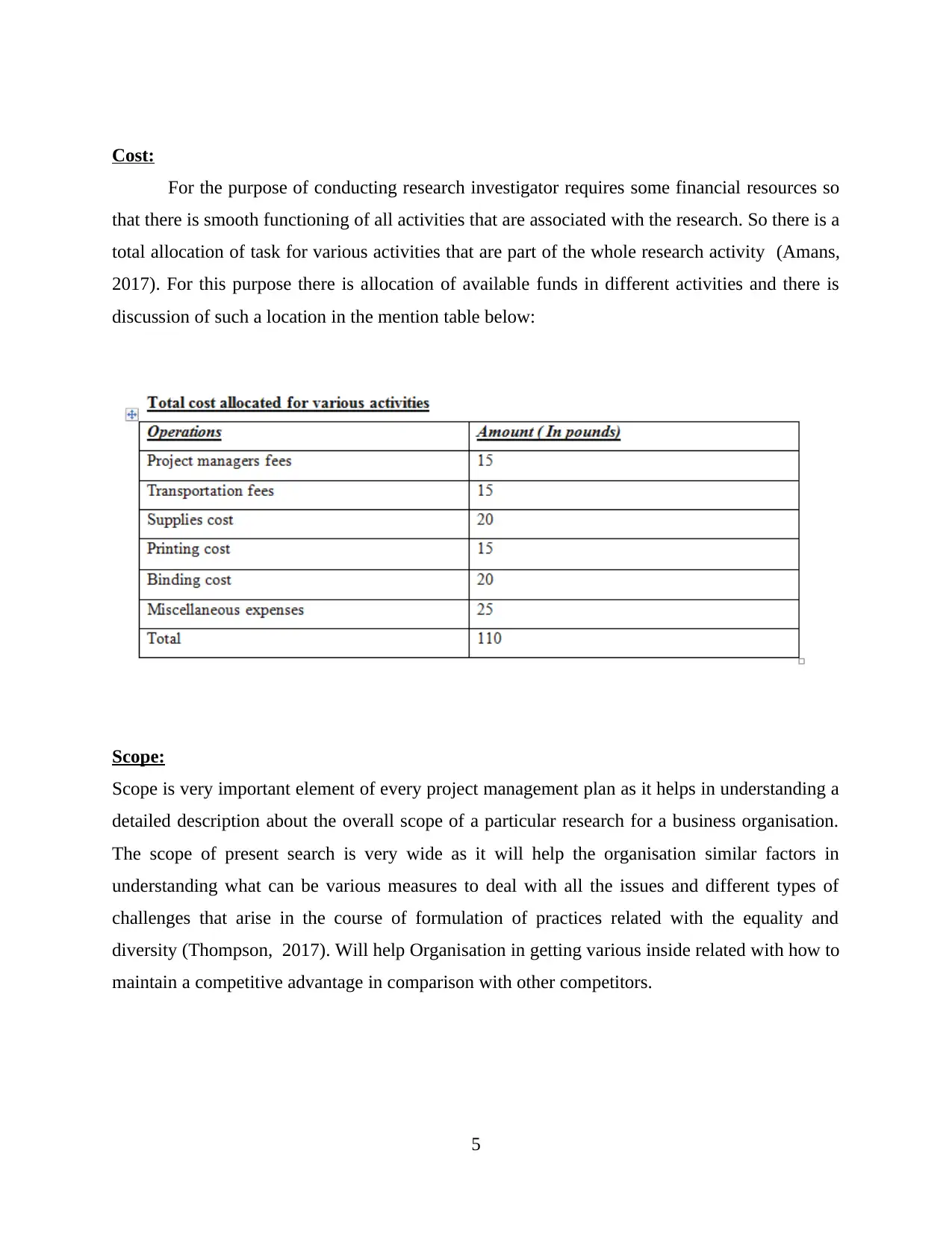
Cost:
For the purpose of conducting research investigator requires some financial resources so
that there is smooth functioning of all activities that are associated with the research. So there is a
total allocation of task for various activities that are part of the whole research activity (Amans,
2017). For this purpose there is allocation of available funds in different activities and there is
discussion of such a location in the mention table below:
Scope:
Scope is very important element of every project management plan as it helps in understanding a
detailed description about the overall scope of a particular research for a business organisation.
The scope of present search is very wide as it will help the organisation similar factors in
understanding what can be various measures to deal with all the issues and different types of
challenges that arise in the course of formulation of practices related with the equality and
diversity (Thompson, 2017). Will help Organisation in getting various inside related with how to
maintain a competitive advantage in comparison with other competitors.
5
For the purpose of conducting research investigator requires some financial resources so
that there is smooth functioning of all activities that are associated with the research. So there is a
total allocation of task for various activities that are part of the whole research activity (Amans,
2017). For this purpose there is allocation of available funds in different activities and there is
discussion of such a location in the mention table below:
Scope:
Scope is very important element of every project management plan as it helps in understanding a
detailed description about the overall scope of a particular research for a business organisation.
The scope of present search is very wide as it will help the organisation similar factors in
understanding what can be various measures to deal with all the issues and different types of
challenges that arise in the course of formulation of practices related with the equality and
diversity (Thompson, 2017). Will help Organisation in getting various inside related with how to
maintain a competitive advantage in comparison with other competitors.
5
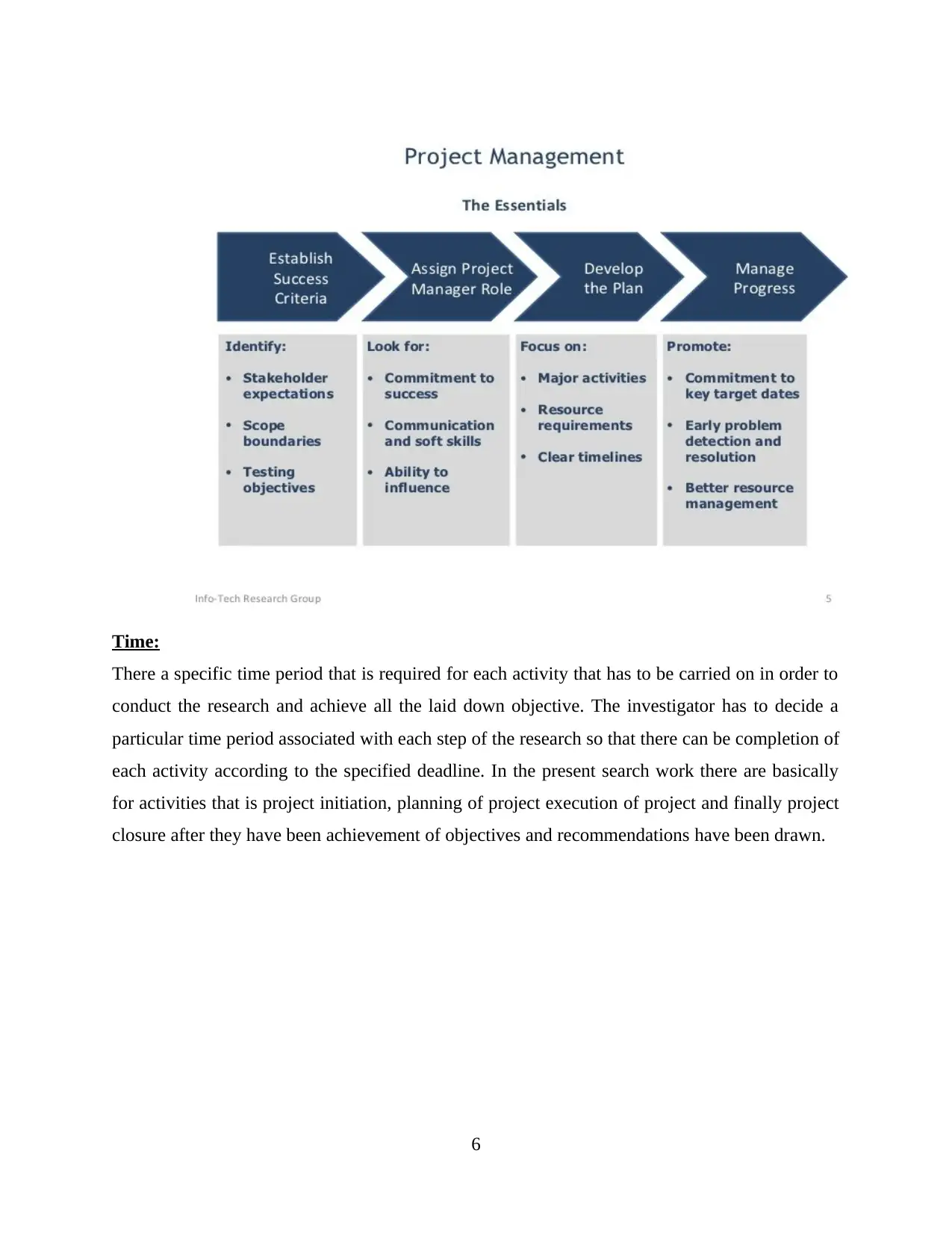
Time:
There a specific time period that is required for each activity that has to be carried on in order to
conduct the research and achieve all the laid down objective. The investigator has to decide a
particular time period associated with each step of the research so that there can be completion of
each activity according to the specified deadline. In the present search work there are basically
for activities that is project initiation, planning of project execution of project and finally project
closure after they have been achievement of objectives and recommendations have been drawn.
6
There a specific time period that is required for each activity that has to be carried on in order to
conduct the research and achieve all the laid down objective. The investigator has to decide a
particular time period associated with each step of the research so that there can be completion of
each activity according to the specified deadline. In the present search work there are basically
for activities that is project initiation, planning of project execution of project and finally project
closure after they have been achievement of objectives and recommendations have been drawn.
6
⊘ This is a preview!⊘
Do you want full access?
Subscribe today to unlock all pages.

Trusted by 1+ million students worldwide
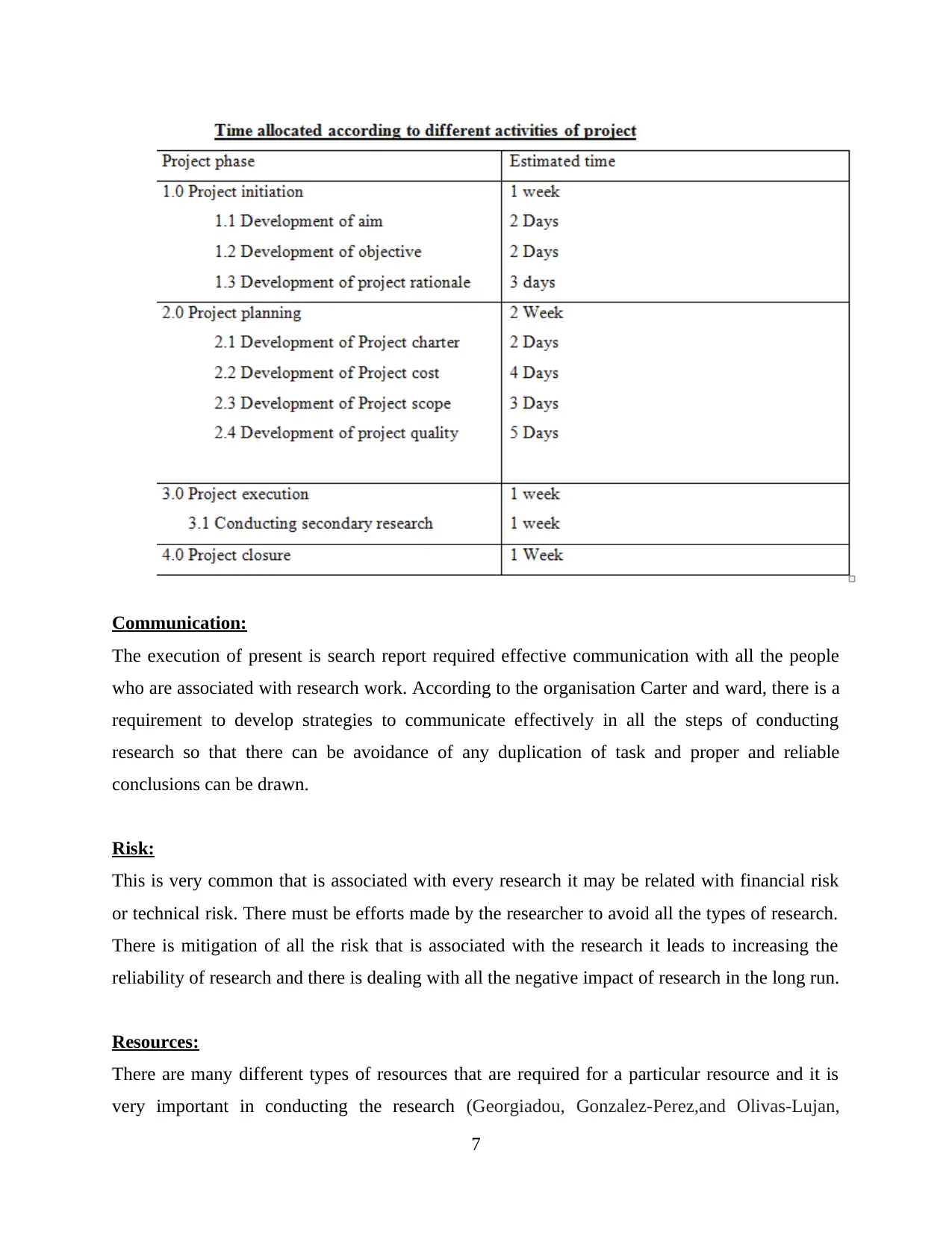
Communication:
The execution of present is search report required effective communication with all the people
who are associated with research work. According to the organisation Carter and ward, there is a
requirement to develop strategies to communicate effectively in all the steps of conducting
research so that there can be avoidance of any duplication of task and proper and reliable
conclusions can be drawn.
Risk:
This is very common that is associated with every research it may be related with financial risk
or technical risk. There must be efforts made by the researcher to avoid all the types of research.
There is mitigation of all the risk that is associated with the research it leads to increasing the
reliability of research and there is dealing with all the negative impact of research in the long run.
Resources:
There are many different types of resources that are required for a particular resource and it is
very important in conducting the research (Georgiadou, Gonzalez-Perez,and Olivas-Lujan,
7
The execution of present is search report required effective communication with all the people
who are associated with research work. According to the organisation Carter and ward, there is a
requirement to develop strategies to communicate effectively in all the steps of conducting
research so that there can be avoidance of any duplication of task and proper and reliable
conclusions can be drawn.
Risk:
This is very common that is associated with every research it may be related with financial risk
or technical risk. There must be efforts made by the researcher to avoid all the types of research.
There is mitigation of all the risk that is associated with the research it leads to increasing the
reliability of research and there is dealing with all the negative impact of research in the long run.
Resources:
There are many different types of resources that are required for a particular resource and it is
very important in conducting the research (Georgiadou, Gonzalez-Perez,and Olivas-Lujan,
7
Paraphrase This Document
Need a fresh take? Get an instant paraphrase of this document with our AI Paraphraser
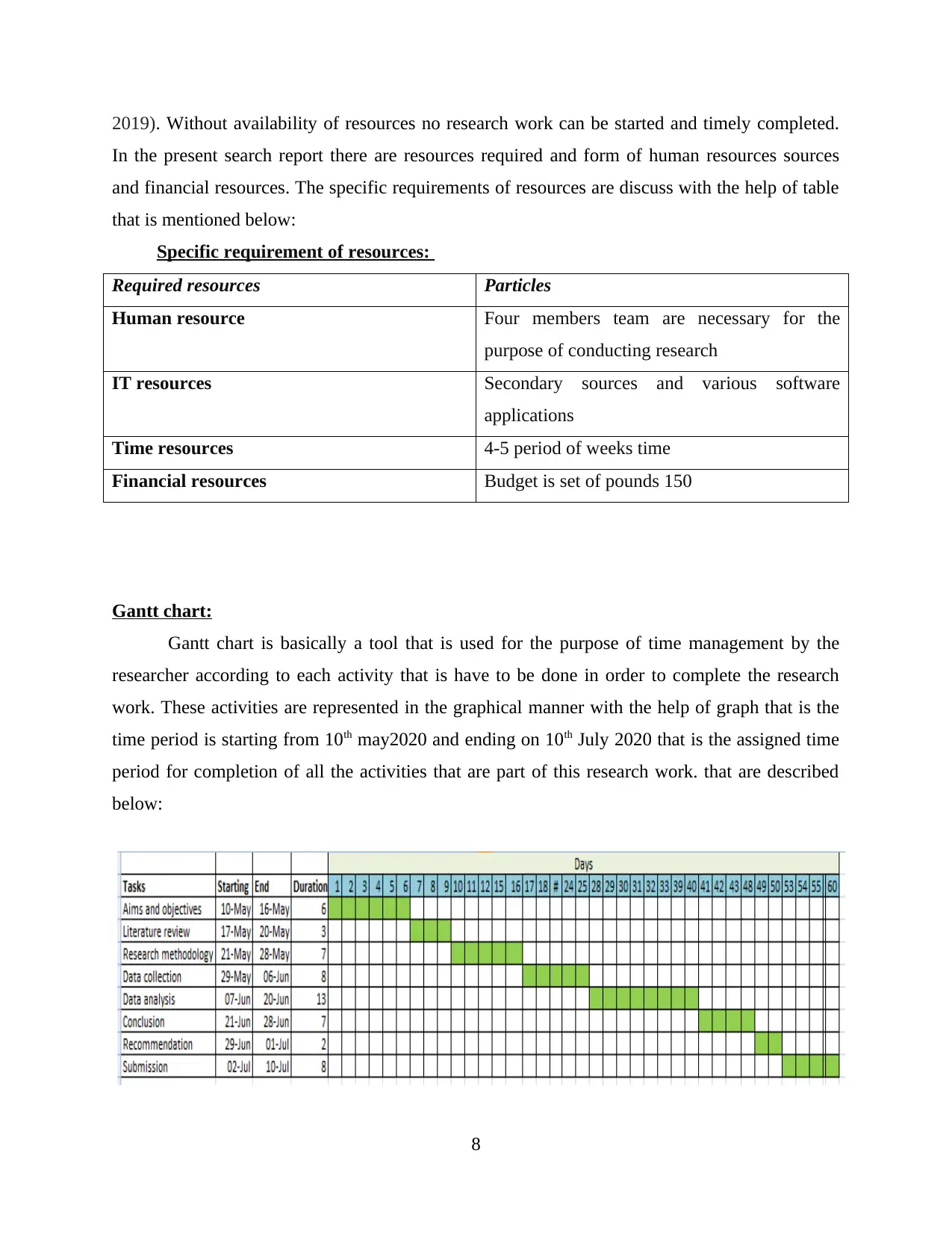
2019). Without availability of resources no research work can be started and timely completed.
In the present search report there are resources required and form of human resources sources
and financial resources. The specific requirements of resources are discuss with the help of table
that is mentioned below:
Specific requirement of resources:
Required resources Particles
Human resource Four members team are necessary for the
purpose of conducting research
IT resources Secondary sources and various software
applications
Time resources 4-5 period of weeks time
Financial resources Budget is set of pounds 150
Gantt chart:
Gantt chart is basically a tool that is used for the purpose of time management by the
researcher according to each activity that is have to be done in order to complete the research
work. These activities are represented in the graphical manner with the help of graph that is the
time period is starting from 10th may2020 and ending on 10th July 2020 that is the assigned time
period for completion of all the activities that are part of this research work. that are described
below:
8
In the present search report there are resources required and form of human resources sources
and financial resources. The specific requirements of resources are discuss with the help of table
that is mentioned below:
Specific requirement of resources:
Required resources Particles
Human resource Four members team are necessary for the
purpose of conducting research
IT resources Secondary sources and various software
applications
Time resources 4-5 period of weeks time
Financial resources Budget is set of pounds 150
Gantt chart:
Gantt chart is basically a tool that is used for the purpose of time management by the
researcher according to each activity that is have to be done in order to complete the research
work. These activities are represented in the graphical manner with the help of graph that is the
time period is starting from 10th may2020 and ending on 10th July 2020 that is the assigned time
period for completion of all the activities that are part of this research work. that are described
below:
8
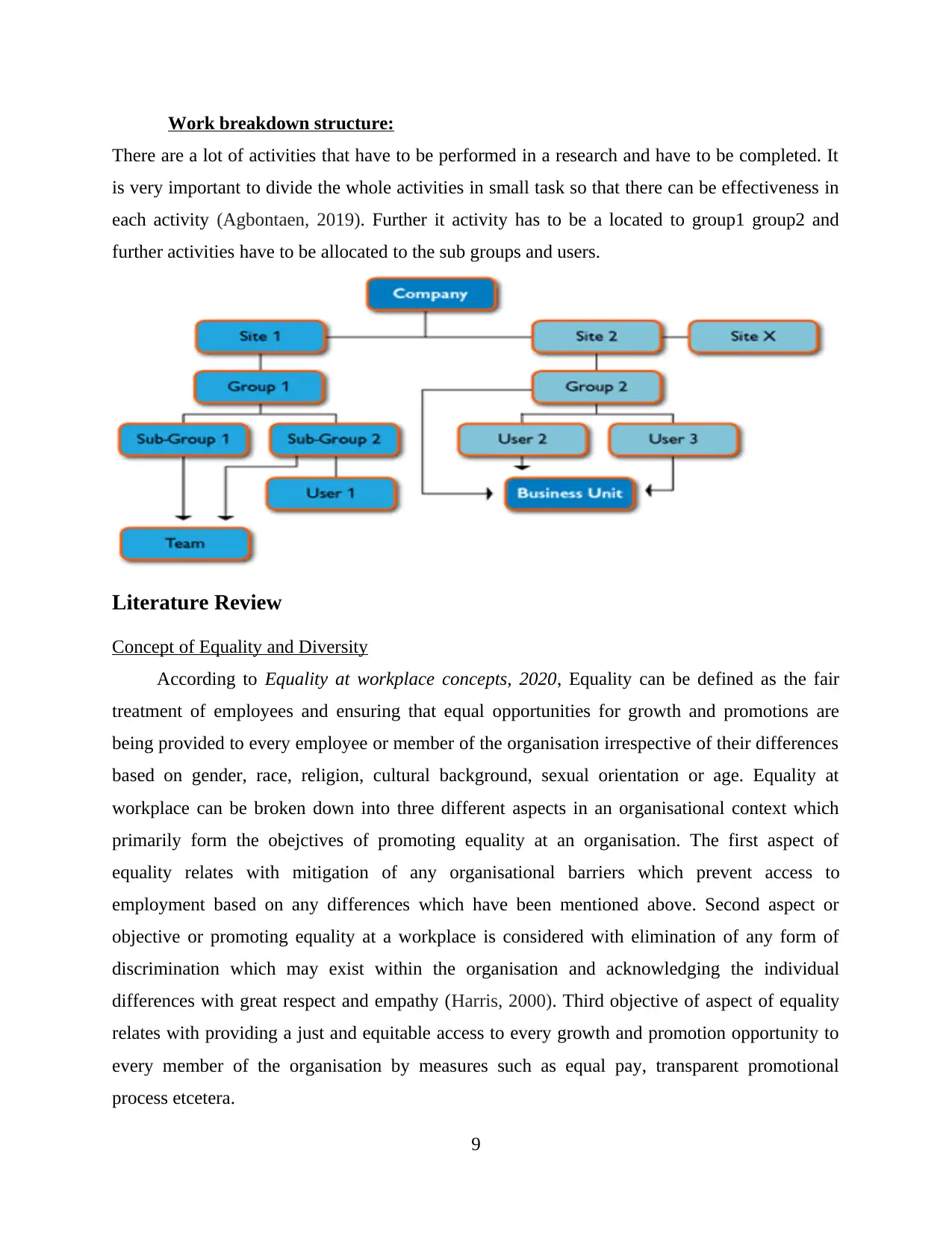
Work breakdown structure:
There are a lot of activities that have to be performed in a research and have to be completed. It
is very important to divide the whole activities in small task so that there can be effectiveness in
each activity (Agbontaen, 2019). Further it activity has to be a located to group1 group2 and
further activities have to be allocated to the sub groups and users.
Literature Review
Concept of Equality and Diversity
According to Equality at workplace concepts, 2020, Equality can be defined as the fair
treatment of employees and ensuring that equal opportunities for growth and promotions are
being provided to every employee or member of the organisation irrespective of their differences
based on gender, race, religion, cultural background, sexual orientation or age. Equality at
workplace can be broken down into three different aspects in an organisational context which
primarily form the obejctives of promoting equality at an organisation. The first aspect of
equality relates with mitigation of any organisational barriers which prevent access to
employment based on any differences which have been mentioned above. Second aspect or
objective or promoting equality at a workplace is considered with elimination of any form of
discrimination which may exist within the organisation and acknowledging the individual
differences with great respect and empathy (Harris, 2000). Third objective of aspect of equality
relates with providing a just and equitable access to every growth and promotion opportunity to
every member of the organisation by measures such as equal pay, transparent promotional
process etcetera.
9
There are a lot of activities that have to be performed in a research and have to be completed. It
is very important to divide the whole activities in small task so that there can be effectiveness in
each activity (Agbontaen, 2019). Further it activity has to be a located to group1 group2 and
further activities have to be allocated to the sub groups and users.
Literature Review
Concept of Equality and Diversity
According to Equality at workplace concepts, 2020, Equality can be defined as the fair
treatment of employees and ensuring that equal opportunities for growth and promotions are
being provided to every employee or member of the organisation irrespective of their differences
based on gender, race, religion, cultural background, sexual orientation or age. Equality at
workplace can be broken down into three different aspects in an organisational context which
primarily form the obejctives of promoting equality at an organisation. The first aspect of
equality relates with mitigation of any organisational barriers which prevent access to
employment based on any differences which have been mentioned above. Second aspect or
objective or promoting equality at a workplace is considered with elimination of any form of
discrimination which may exist within the organisation and acknowledging the individual
differences with great respect and empathy (Harris, 2000). Third objective of aspect of equality
relates with providing a just and equitable access to every growth and promotion opportunity to
every member of the organisation by measures such as equal pay, transparent promotional
process etcetera.
9
⊘ This is a preview!⊘
Do you want full access?
Subscribe today to unlock all pages.

Trusted by 1+ million students worldwide
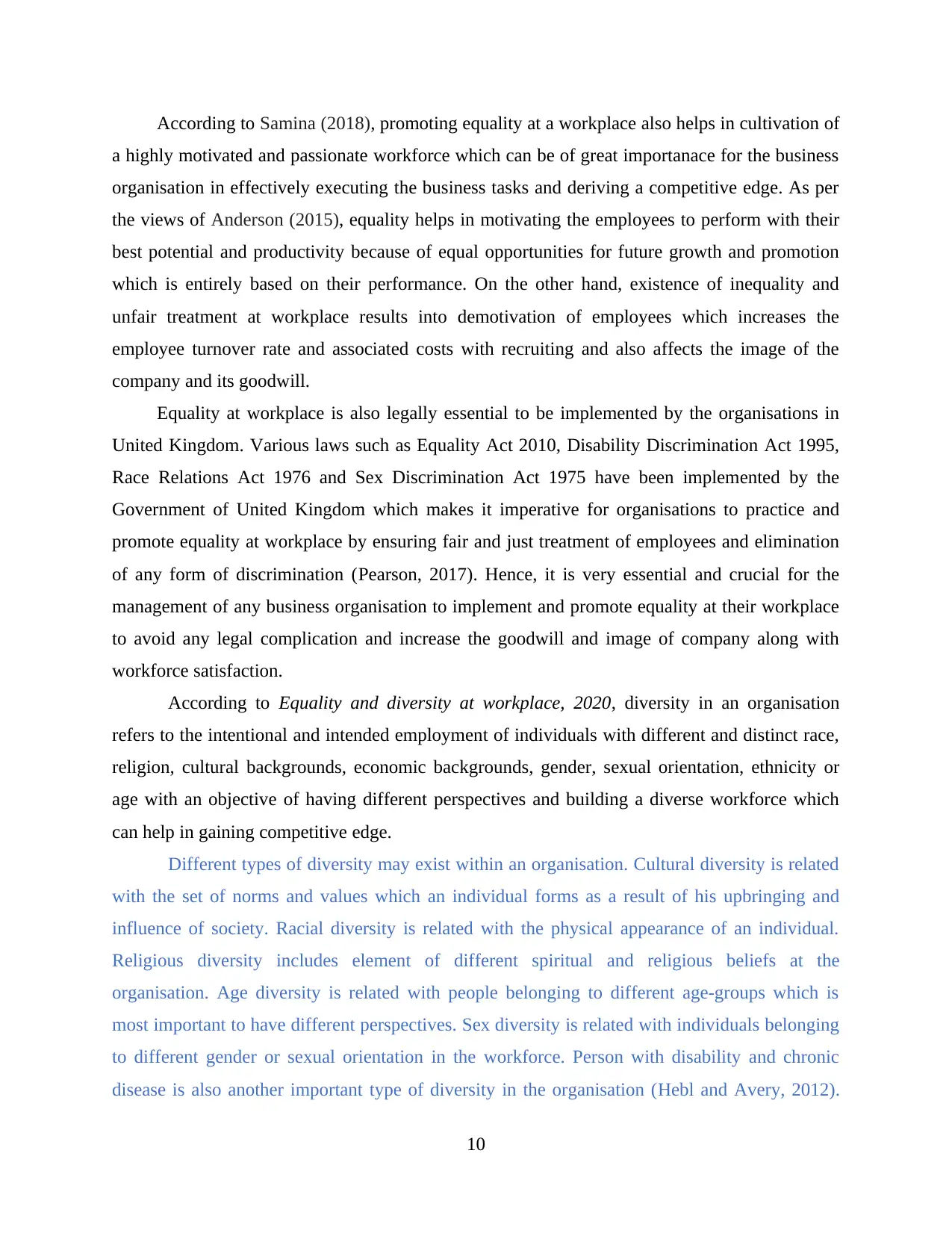
According to Samina (2018), promoting equality at a workplace also helps in cultivation of
a highly motivated and passionate workforce which can be of great importanace for the business
organisation in effectively executing the business tasks and deriving a competitive edge. As per
the views of Anderson (2015), equality helps in motivating the employees to perform with their
best potential and productivity because of equal opportunities for future growth and promotion
which is entirely based on their performance. On the other hand, existence of inequality and
unfair treatment at workplace results into demotivation of employees which increases the
employee turnover rate and associated costs with recruiting and also affects the image of the
company and its goodwill.
Equality at workplace is also legally essential to be implemented by the organisations in
United Kingdom. Various laws such as Equality Act 2010, Disability Discrimination Act 1995,
Race Relations Act 1976 and Sex Discrimination Act 1975 have been implemented by the
Government of United Kingdom which makes it imperative for organisations to practice and
promote equality at workplace by ensuring fair and just treatment of employees and elimination
of any form of discrimination (Pearson, 2017). Hence, it is very essential and crucial for the
management of any business organisation to implement and promote equality at their workplace
to avoid any legal complication and increase the goodwill and image of company along with
workforce satisfaction.
According to Equality and diversity at workplace, 2020, diversity in an organisation
refers to the intentional and intended employment of individuals with different and distinct race,
religion, cultural backgrounds, economic backgrounds, gender, sexual orientation, ethnicity or
age with an objective of having different perspectives and building a diverse workforce which
can help in gaining competitive edge.
Different types of diversity may exist within an organisation. Cultural diversity is related
with the set of norms and values which an individual forms as a result of his upbringing and
influence of society. Racial diversity is related with the physical appearance of an individual.
Religious diversity includes element of different spiritual and religious beliefs at the
organisation. Age diversity is related with people belonging to different age-groups which is
most important to have different perspectives. Sex diversity is related with individuals belonging
to different gender or sexual orientation in the workforce. Person with disability and chronic
disease is also another important type of diversity in the organisation (Hebl and Avery, 2012).
10
a highly motivated and passionate workforce which can be of great importanace for the business
organisation in effectively executing the business tasks and deriving a competitive edge. As per
the views of Anderson (2015), equality helps in motivating the employees to perform with their
best potential and productivity because of equal opportunities for future growth and promotion
which is entirely based on their performance. On the other hand, existence of inequality and
unfair treatment at workplace results into demotivation of employees which increases the
employee turnover rate and associated costs with recruiting and also affects the image of the
company and its goodwill.
Equality at workplace is also legally essential to be implemented by the organisations in
United Kingdom. Various laws such as Equality Act 2010, Disability Discrimination Act 1995,
Race Relations Act 1976 and Sex Discrimination Act 1975 have been implemented by the
Government of United Kingdom which makes it imperative for organisations to practice and
promote equality at workplace by ensuring fair and just treatment of employees and elimination
of any form of discrimination (Pearson, 2017). Hence, it is very essential and crucial for the
management of any business organisation to implement and promote equality at their workplace
to avoid any legal complication and increase the goodwill and image of company along with
workforce satisfaction.
According to Equality and diversity at workplace, 2020, diversity in an organisation
refers to the intentional and intended employment of individuals with different and distinct race,
religion, cultural backgrounds, economic backgrounds, gender, sexual orientation, ethnicity or
age with an objective of having different perspectives and building a diverse workforce which
can help in gaining competitive edge.
Different types of diversity may exist within an organisation. Cultural diversity is related
with the set of norms and values which an individual forms as a result of his upbringing and
influence of society. Racial diversity is related with the physical appearance of an individual.
Religious diversity includes element of different spiritual and religious beliefs at the
organisation. Age diversity is related with people belonging to different age-groups which is
most important to have different perspectives. Sex diversity is related with individuals belonging
to different gender or sexual orientation in the workforce. Person with disability and chronic
disease is also another important type of diversity in the organisation (Hebl and Avery, 2012).
10
Paraphrase This Document
Need a fresh take? Get an instant paraphrase of this document with our AI Paraphraser
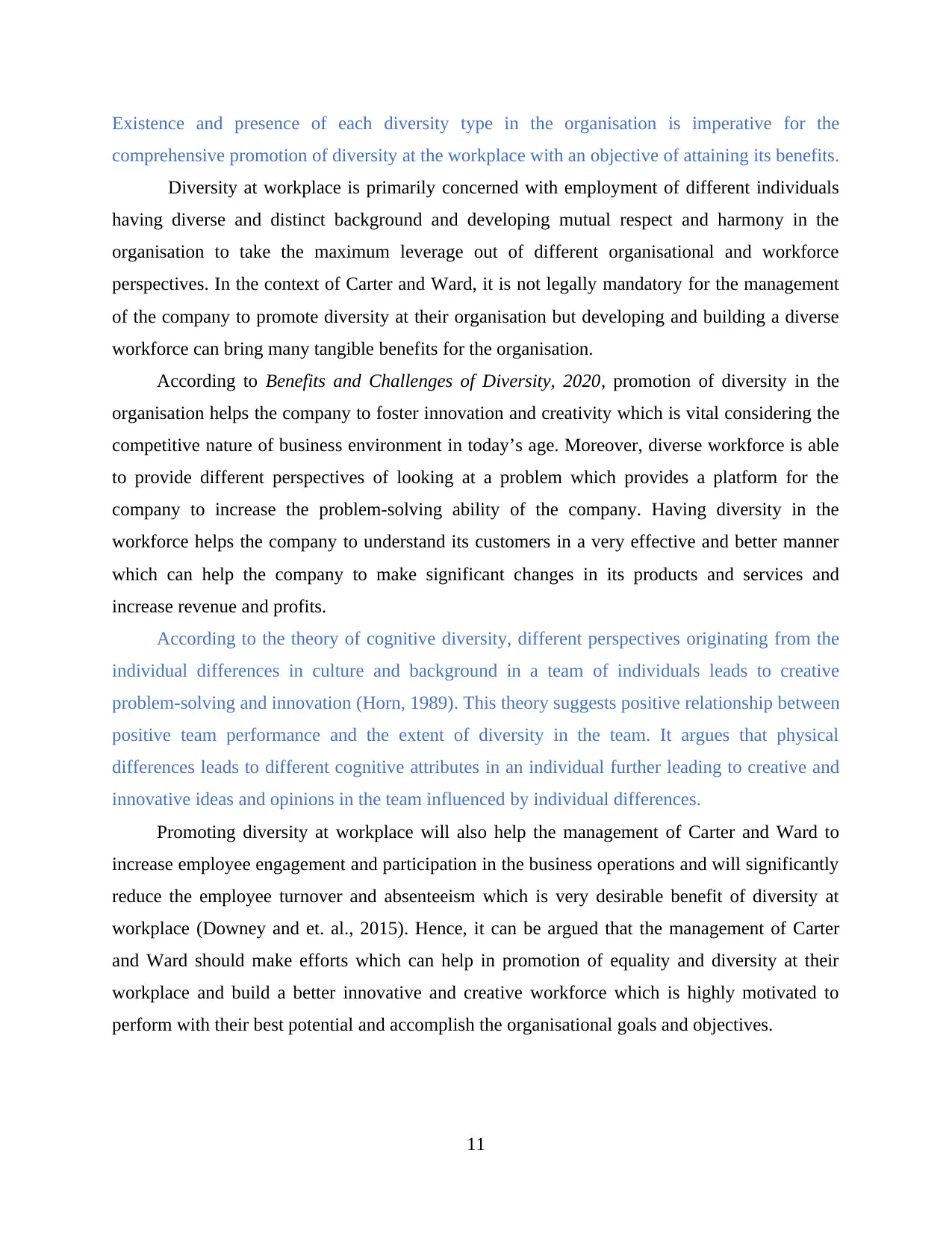
Existence and presence of each diversity type in the organisation is imperative for the
comprehensive promotion of diversity at the workplace with an objective of attaining its benefits.
Diversity at workplace is primarily concerned with employment of different individuals
having diverse and distinct background and developing mutual respect and harmony in the
organisation to take the maximum leverage out of different organisational and workforce
perspectives. In the context of Carter and Ward, it is not legally mandatory for the management
of the company to promote diversity at their organisation but developing and building a diverse
workforce can bring many tangible benefits for the organisation.
According to Benefits and Challenges of Diversity, 2020, promotion of diversity in the
organisation helps the company to foster innovation and creativity which is vital considering the
competitive nature of business environment in today’s age. Moreover, diverse workforce is able
to provide different perspectives of looking at a problem which provides a platform for the
company to increase the problem-solving ability of the company. Having diversity in the
workforce helps the company to understand its customers in a very effective and better manner
which can help the company to make significant changes in its products and services and
increase revenue and profits.
According to the theory of cognitive diversity, different perspectives originating from the
individual differences in culture and background in a team of individuals leads to creative
problem-solving and innovation (Horn, 1989). This theory suggests positive relationship between
positive team performance and the extent of diversity in the team. It argues that physical
differences leads to different cognitive attributes in an individual further leading to creative and
innovative ideas and opinions in the team influenced by individual differences.
Promoting diversity at workplace will also help the management of Carter and Ward to
increase employee engagement and participation in the business operations and will significantly
reduce the employee turnover and absenteeism which is very desirable benefit of diversity at
workplace (Downey and et. al., 2015). Hence, it can be argued that the management of Carter
and Ward should make efforts which can help in promotion of equality and diversity at their
workplace and build a better innovative and creative workforce which is highly motivated to
perform with their best potential and accomplish the organisational goals and objectives.
11
comprehensive promotion of diversity at the workplace with an objective of attaining its benefits.
Diversity at workplace is primarily concerned with employment of different individuals
having diverse and distinct background and developing mutual respect and harmony in the
organisation to take the maximum leverage out of different organisational and workforce
perspectives. In the context of Carter and Ward, it is not legally mandatory for the management
of the company to promote diversity at their organisation but developing and building a diverse
workforce can bring many tangible benefits for the organisation.
According to Benefits and Challenges of Diversity, 2020, promotion of diversity in the
organisation helps the company to foster innovation and creativity which is vital considering the
competitive nature of business environment in today’s age. Moreover, diverse workforce is able
to provide different perspectives of looking at a problem which provides a platform for the
company to increase the problem-solving ability of the company. Having diversity in the
workforce helps the company to understand its customers in a very effective and better manner
which can help the company to make significant changes in its products and services and
increase revenue and profits.
According to the theory of cognitive diversity, different perspectives originating from the
individual differences in culture and background in a team of individuals leads to creative
problem-solving and innovation (Horn, 1989). This theory suggests positive relationship between
positive team performance and the extent of diversity in the team. It argues that physical
differences leads to different cognitive attributes in an individual further leading to creative and
innovative ideas and opinions in the team influenced by individual differences.
Promoting diversity at workplace will also help the management of Carter and Ward to
increase employee engagement and participation in the business operations and will significantly
reduce the employee turnover and absenteeism which is very desirable benefit of diversity at
workplace (Downey and et. al., 2015). Hence, it can be argued that the management of Carter
and Ward should make efforts which can help in promotion of equality and diversity at their
workplace and build a better innovative and creative workforce which is highly motivated to
perform with their best potential and accomplish the organisational goals and objectives.
11
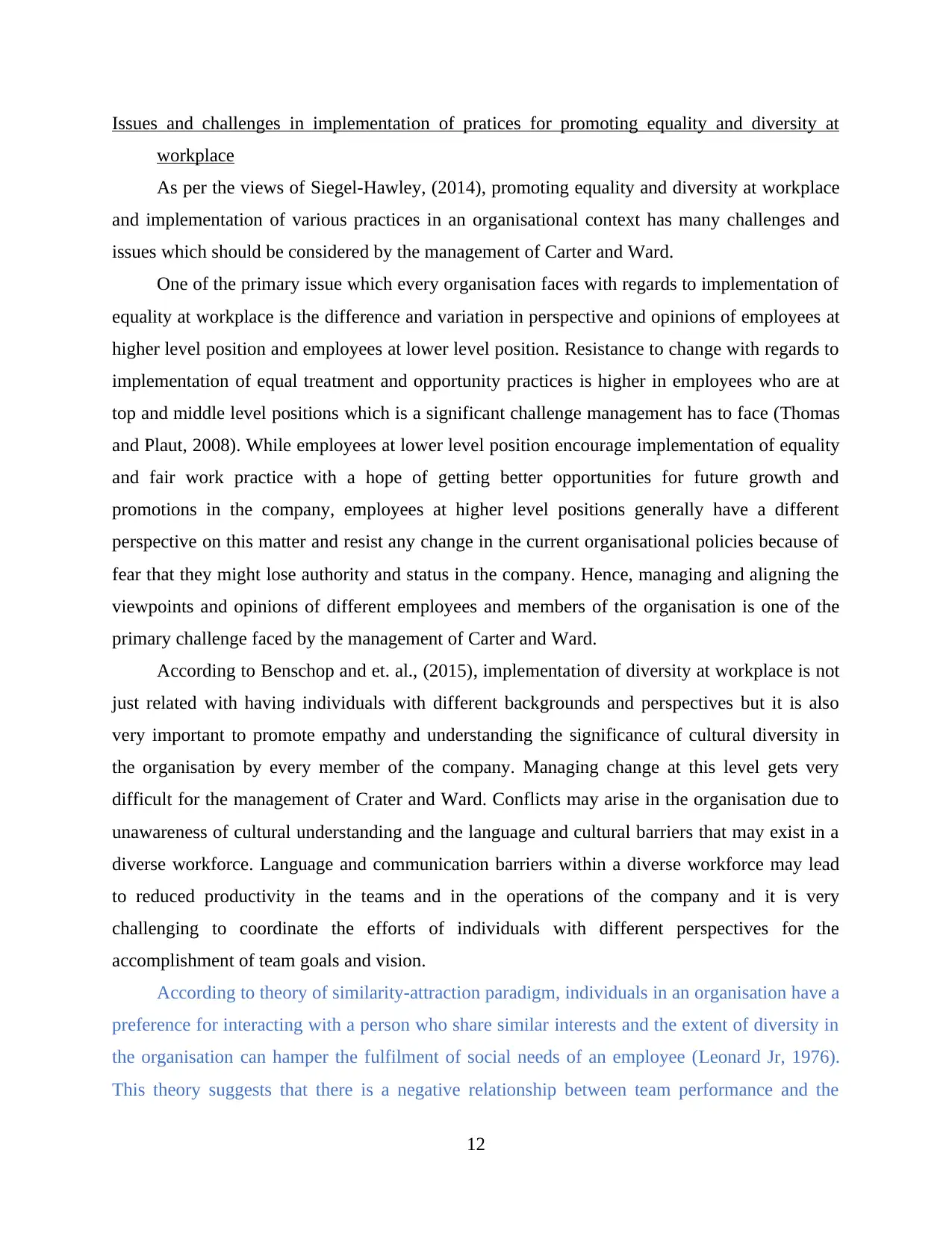
Issues and challenges in implementation of pratices for promoting equality and diversity at
workplace
As per the views of Siegel-Hawley, (2014), promoting equality and diversity at workplace
and implementation of various practices in an organisational context has many challenges and
issues which should be considered by the management of Carter and Ward.
One of the primary issue which every organisation faces with regards to implementation of
equality at workplace is the difference and variation in perspective and opinions of employees at
higher level position and employees at lower level position. Resistance to change with regards to
implementation of equal treatment and opportunity practices is higher in employees who are at
top and middle level positions which is a significant challenge management has to face (Thomas
and Plaut, 2008). While employees at lower level position encourage implementation of equality
and fair work practice with a hope of getting better opportunities for future growth and
promotions in the company, employees at higher level positions generally have a different
perspective on this matter and resist any change in the current organisational policies because of
fear that they might lose authority and status in the company. Hence, managing and aligning the
viewpoints and opinions of different employees and members of the organisation is one of the
primary challenge faced by the management of Carter and Ward.
According to Benschop and et. al., (2015), implementation of diversity at workplace is not
just related with having individuals with different backgrounds and perspectives but it is also
very important to promote empathy and understanding the significance of cultural diversity in
the organisation by every member of the company. Managing change at this level gets very
difficult for the management of Crater and Ward. Conflicts may arise in the organisation due to
unawareness of cultural understanding and the language and cultural barriers that may exist in a
diverse workforce. Language and communication barriers within a diverse workforce may lead
to reduced productivity in the teams and in the operations of the company and it is very
challenging to coordinate the efforts of individuals with different perspectives for the
accomplishment of team goals and vision.
According to theory of similarity-attraction paradigm, individuals in an organisation have a
preference for interacting with a person who share similar interests and the extent of diversity in
the organisation can hamper the fulfilment of social needs of an employee (Leonard Jr, 1976).
This theory suggests that there is a negative relationship between team performance and the
12
workplace
As per the views of Siegel-Hawley, (2014), promoting equality and diversity at workplace
and implementation of various practices in an organisational context has many challenges and
issues which should be considered by the management of Carter and Ward.
One of the primary issue which every organisation faces with regards to implementation of
equality at workplace is the difference and variation in perspective and opinions of employees at
higher level position and employees at lower level position. Resistance to change with regards to
implementation of equal treatment and opportunity practices is higher in employees who are at
top and middle level positions which is a significant challenge management has to face (Thomas
and Plaut, 2008). While employees at lower level position encourage implementation of equality
and fair work practice with a hope of getting better opportunities for future growth and
promotions in the company, employees at higher level positions generally have a different
perspective on this matter and resist any change in the current organisational policies because of
fear that they might lose authority and status in the company. Hence, managing and aligning the
viewpoints and opinions of different employees and members of the organisation is one of the
primary challenge faced by the management of Carter and Ward.
According to Benschop and et. al., (2015), implementation of diversity at workplace is not
just related with having individuals with different backgrounds and perspectives but it is also
very important to promote empathy and understanding the significance of cultural diversity in
the organisation by every member of the company. Managing change at this level gets very
difficult for the management of Crater and Ward. Conflicts may arise in the organisation due to
unawareness of cultural understanding and the language and cultural barriers that may exist in a
diverse workforce. Language and communication barriers within a diverse workforce may lead
to reduced productivity in the teams and in the operations of the company and it is very
challenging to coordinate the efforts of individuals with different perspectives for the
accomplishment of team goals and vision.
According to theory of similarity-attraction paradigm, individuals in an organisation have a
preference for interacting with a person who share similar interests and the extent of diversity in
the organisation can hamper the fulfilment of social needs of an employee (Leonard Jr, 1976).
This theory suggests that there is a negative relationship between team performance and the
12
⊘ This is a preview!⊘
Do you want full access?
Subscribe today to unlock all pages.

Trusted by 1+ million students worldwide
1 out of 29
Related Documents
Your All-in-One AI-Powered Toolkit for Academic Success.
+13062052269
info@desklib.com
Available 24*7 on WhatsApp / Email
![[object Object]](/_next/static/media/star-bottom.7253800d.svg)
Unlock your academic potential
Copyright © 2020–2025 A2Z Services. All Rights Reserved. Developed and managed by ZUCOL.





